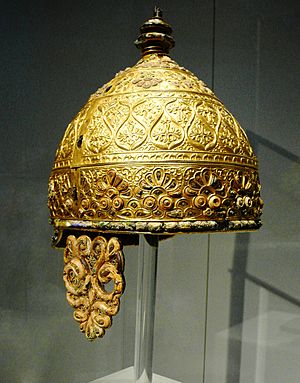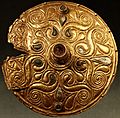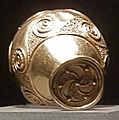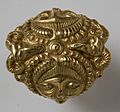Celts facts for kids
The Celts were a large group of ancient tribes in Europe. They first appeared around 1200 B.C. in Austria, during the early Iron Age. The name 'Celt' was given to them by the Romans; the Celts themselves did not use this word. Their culture and people spread across much of Europe. By the time the Greeks and Romans became powerful, Celtic tribes lived in the British Isles and parts of western, southern, and eastern Europe. The most well-known Celtic tribes were in Gaul (modern-day France).
The Celts spoke Celtic languages. Today, some Celtic languages still exist, such as Breton, Cornish, Welsh, and Gaelic languages.
Celtic society and technology were quite advanced for their time, though not as much as the Romans. They lived by strong ethical and honor codes. Their culture was rich with unique drawings, sculptures, jewelry, folklore, and building styles. They were also skilled in blacksmithing, farming, and diplomacy.
Celtic warriors often wore war paint and shouted war cries to scare their enemies. Different tribes had different battle clothes. Some warriors wore chainmail or leather armor. Others wore only clothes, and some were known to fight without any clothes at all. They used strong swords and very protective shields.
When the Roman Republic began to grow, the Gauls and Romans often fought. The Romans eventually defeated most Celtic tribes in Europe. They ruled these lands until the Roman Empire fell. Celtic tribes also fought among themselves. After winning a battle, Celts would take trophies from their defeated enemies.
After the Roman Empire fell, most old Celtic lands were taken over by migrating Germanic tribes. These groups mixed with people who had both Roman and Celtic backgrounds. This mix eventually formed several European nations we know today, like France. Today, regions still considered Celtic include Ireland, Wales, Scotland, the Isle of Man, Cornwall, and Brittany.
Celtic Life and Art
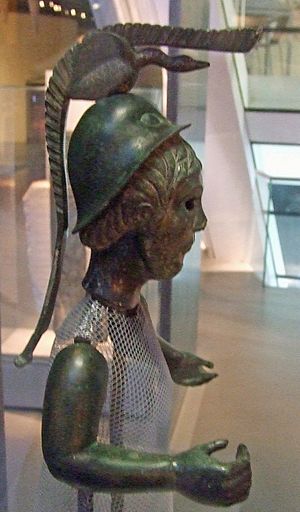
Ancient writings tell us that early Celtic society was based on social classes and family ties. Like the Romans, they also had a system where powerful people helped less powerful ones.
Most Celtic tribes were led by kings. However, some areas near Rome might have started to have governments led by a few powerful people. Celtic societies were usually divided into three main groups:
- Warriors (the leaders and fighters)
- Intellectuals (like druids, poets, and judges)
- Everyone else (farmers, craftspeople, etc.)
Sometimes, women were involved in warfare and even became queens, though this was not common. In Ireland and Scotland, kings were chosen by a system called tanistry. This meant they were elected, which was different from the feudal system where the oldest son always inherited the title.
Fighting was a regular part of Celtic life. Ancient stories describe battles as more like sports or raids for hunting. But historical records show that tribes used warfare to gain political power, harass rivals, get economic benefits, and sometimes conquer land.
Celtic settlements varied. Some lived in scattered homes or hillforts. Others lived in larger towns, especially in the core Hallstatt and La Tene areas. Gaul also had many important towns called oppida.
Archaeological finds show that pre-Roman Celtic societies were part of a large trade network. This network stretched across Eurasia, from Ireland to China. Celtic traders also connected with the Phoenicians. Gold items made in ancient Ireland have been found in Palestine. This shows trade routes between Atlantic societies and Palestine existed as early as 1600 BC.
Local trade often involved bartering (exchanging goods directly). Like many tribal societies, they likely had a "reciprocal economy." This means goods and services were given based on relationships and family duties, not always exchanged for money. However, low-value coins made of different metals were used for trade in most Celtic areas of Europe and in Southeast Britain before the Romans conquered them.
Very few records written in Celtic languages from before Christianity exist. These are mostly inscriptions using Roman or Greek letters. The Ogham script was mainly used in early Christian times in Ireland and Scotland. It was mostly for special purposes, like inscriptions on gravestones.
Evidence suggests the Celts had a strong oral tradition. This means stories and knowledge were passed down by speaking, not writing. Bards (poets and storytellers) in Ireland kept this tradition alive. Later, monasteries wrote down these stories. The oldest recorded rhyming poetry in the world is from Ireland. Some scholars believe the Celts might have invented Rhyme.
The Celts were very skilled in visual arts. Celtic art produced many detailed and beautiful metalworks. Many examples have been preserved because of their unique burial customs.
Some Celtic groups, especially those near the Atlantic, were traditional. For example, they still used chariots in battle long after the Greeks and Romans used them only for ceremonies. When Julius Caesar invaded Britain, the Celtic chariot tactics even helped defeat his army.
Celtic Beliefs
The Celtic religion had some common patterns, even though gods varied by region and tribe. For example, many early Celts worshipped in sacred groves (groups of trees). This practice was common in many ancient religions. Later, La Tène Celts also built temples of different sizes and shapes. However, they often still kept sacred trees or pools nearby. When temples were available, worship often happened there. Many Celtic temples were easily changed by the Romans into their own temples. This was because their designs were similar, both being influenced by Greek architecture.
Druids were important members of Celtic society. A druid was not always a priest. Any Celt who had what we would call a "college education" was a druid. The most educated druids were often doctors, priests, and messengers. These jobs needed a lot of memory and skill. Priests from this group were in charge of many religious festivals. They also organized the calendar. This was a difficult job because the Celtic calendar was very accurate but needed to be adjusted by hand about every 40 years. This required complex math.
Druids led religious ceremonies and festivals. Sometimes, they made offerings of crops and animals. In special cases, during certain festivals, human sacrifices were part of their rituals. However, this was rare and usually involved criminals.
Celtic gods were often named after things in nature. For example, the source of rivers often had their own goddesses. Another common theme was "triple deities," meaning gods or goddesses that appeared in groups of three. The main gods in Celtic religion were usually male. Some myths say the world was created by a god with a hammer, like Dagda or Sucellos. This god then poured all life from a magic cauldron or cup. This might be where some "Holy Grail" myths in Celtic societies came from.
While gods varied, some important gods or heroes were worshipped in many places. A good example is Lugos, a heroic sun god from Gaul and southern Britain. He is also known as Lugh in Ireland and Lleu in Wales. Early pictures of him exist from the Hallstatt era, showing he was one of the oldest Celtic gods.
Another widespread deity was Epona, the horse and fertility goddess. The Romans also worshipped her when they ruled Gaul. She also seems to have existed from early times. Finally, Sucellos is believed by some to have been the "creator of the universe" in some Celtic religions. He was worshipped over a huge area, even by non-Celtic people. He was the special god of the Ordovices tribe in Britain.
Other religious practices also existed. Celts seemed to remove body hair universally. Some think this was for religious reasons, but it was more likely because Celts were very clean people. Body hair could trap dirt, which they found unacceptable.
Celts also took heads from defeated enemies. This was definitely a religious practice at first. Even after Christianity, some Irish people continued this practice into the Middle Ages. Some even scalped the heads to braid the scalp through rings on their weapons. By then, the religious meaning was less important. But it shows that taking heads had huge cultural importance to last so long. We believe Celts thought the soul lived in the head. They might have believed that capturing a head meant capturing an enemy's soul. And that when a Celt died, the souls they collected would serve them forever. However, there is no definite proof of this.
Images for kids
-
Triskelion and spirals on a Galician torc terminal.
-
The Battersea Shield, a ceremonial bronze shield from 3rd–1st century BC, is an example of La Tène Celtic art from Britain.
-
Stone head from Mšecké Žehrovice, Czech Republic, wearing a torc, late La Tène culture, 150-50 BC.
-
The Celtic god Cernunnos on the Gundestrup cauldron.
See also
 In Spanish: Celta para niños
In Spanish: Celta para niños


